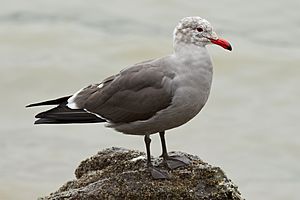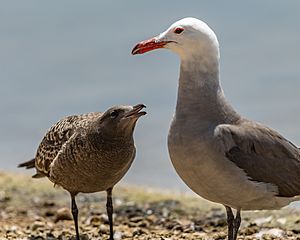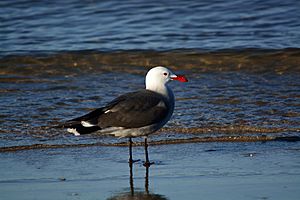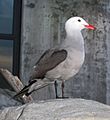Heermann's gull facts for kids
Quick facts for kids Heermann's gull |
|
|---|---|
 |
|
| Adult breeding | |
 |
|
| Adult non-breeding | |
| Conservation status | |
| Scientific classification | |
| Genus: |
Larus
|
| Species: |
heermanni
|
 |
|
| Range of L. heermanni | |
The Heermann's gull (Larus heermanni) is a special type of gull that lives along the coasts of the United States, Mexico, and a small part of southwestern British Columbia. Almost all of these gulls build their nests on a single island called Isla Rasa in the Gulf of California. You'll usually spot them near the ocean or far out at sea, but almost never inland. This bird was named after Adolphus Lewis Heermann, an explorer and naturalist from the 1800s.
Contents
What They Look Like
Heermann's gulls look quite different from other gulls. Adult gulls have a medium gray body and blackish-gray wings and tail with white edges. Their bill is red with a black tip.
Their head color changes with the seasons. When they are not breeding, their head is dusky gray. But during the breeding season, their head turns white.
Young gulls look similar to non-breeding adults but are darker and browner. Their bill is pink until they are about two years old. Sometimes, a few gulls have white spots on their upper wings. This gull is easy to identify because it's the only gull on the west coast of North America with a white head and gray body.
Their calls are deep and sound like other gulls, but they have a unique quality.
Where They Live
About 150,000 pairs of Heermann's gulls exist today. A huge 90% of them nest on Isla Rasa, an island near Baja California in the Gulf of California. Some smaller groups also nest further north in California and south in Nayarit.
After the breeding season, these gulls often fly to central California. Some travel even further north to British Columbia or south to Guatemala. Some gulls return to the same non-breeding spots year after year. For example, a gull with one leg lived for 17 years at the Loch Lomond Marina in San Rafael, California.
The only known active breeding colony of Heermann's gulls in the United States is in Seaside, California. In 1999, a small number of gulls were seen nesting on man-made islands in Roberts Lake. When these islands washed away by 2007, the gulls started nesting on nearby rooftops. In 2019, a special floating island was placed in Roberts Lake to help them nest there again.
What They Eat
Heermann's gulls eat many different things. Their diet includes small fish, tiny sea creatures without backbones, lizards, and insects. They also eat trash and dead animals.
Behavior and Life Cycle
These gulls build their nests together in large groups on the ground, just like many other gulls. They often nest very close to each other, with as many as 110 nests in an area of 100 square meters (about 1,076 square feet). Each female lays two or three eggs. The eggs are grayish-buff to buff with gray and brown marks.
Heermann's gulls sometimes steal food from other seabirds. They often hang around brown pelicans and take fish that the pelicans have caught.
Status and Conservation
Isla Rasa, where most Heermann's gulls nest, was made a protected area in 1964. People are not allowed to collect their eggs or disturb them during the breeding season.
Because almost all of these gulls nest on one small island, they are at risk if a big storm or other natural disaster happens. The success of their breeding each year depends on how much food is available. This food supply is affected by ocean temperature changes, especially those caused by El Niño. Because of these risks, the IUCN has listed this bird as "Near Threatened". This means they are not in immediate danger, but their population could become threatened in the future.
Images for kids
-
Adult Heermann's gull at the Monterey Bay Aquarium
- BirdLife species factsheet for Larus heermanni
- Audio recordings of Heermann's gull on Xeno-canto.
See also
 In Spanish: Gaviota mexicana para niños
In Spanish: Gaviota mexicana para niños









